For your coastal property, consider salt-loving shrubs like Bayberry, Beach Plum, Wax Myrtle, and Inkberry Holly. These hardy plants withstand salt spray, sandy soils, and strong winds while providing wildlife habitat and erosion control. Southern Waxmyrtle grows 5-10 feet tall, creating effective privacy screens, while Winterberry Holly offers striking red berries in fall. With proper watering, mulching, and positioning, these resilient shrubs will transform your maritime landscape for years to come.
Numeric List of 13 Second-Level Headings
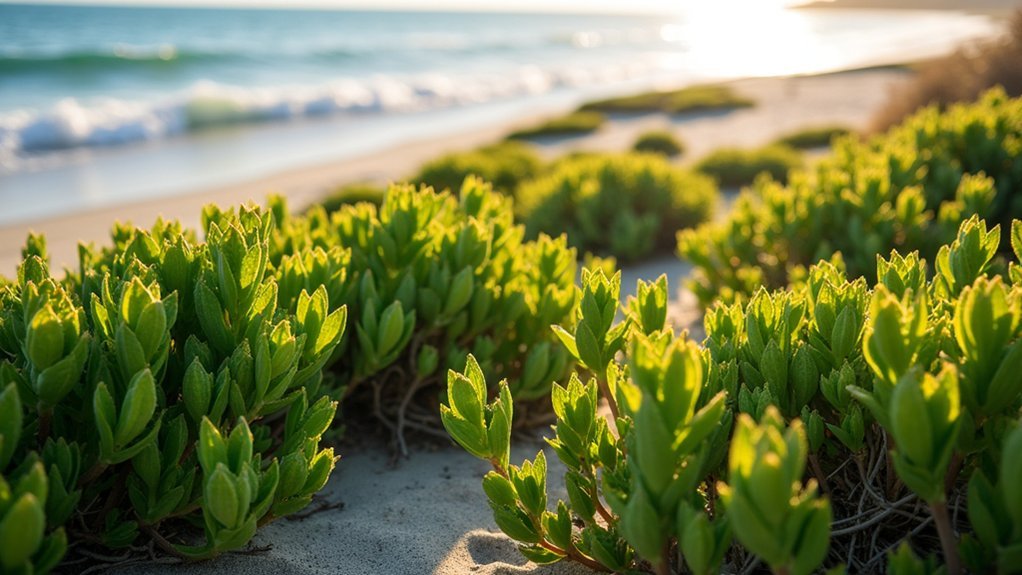
Thirteen salt-tolerant shrubs stand ready to transform your coastal property into a thriving landscape despite challenging conditions.
You’ll find options like Saltbush (Atriplex spp.), which excels in saline soils while providing wildlife habitat and erosion control.
Southern Waxmyrtle offers an evergreen solution at 5-10 feet tall, attracting birds while handling both salt spray and drought.
Southern Waxmyrtle thrives where others fail, creating a verdant haven for birds while standing firm against salt and thirsty conditions.
For larger spaces, consider Live Oak or Southern Red Cedar—both deliver exceptional salt tolerance with minimal maintenance.
If you’re looking for something smaller, Dwarf Palmetto reaches just 6-10 feet tall and serves as a striking specimen plant in coastal gardens.
These coastal plants represent just the beginning of your options for creating a resilient, beautiful landscape that embraces rather than fights your property’s seaside conditions.
Understanding Salt Challenges in Coastal Landscapes
Before selecting the perfect coastal shrubs, you’ll need to comprehend what your plants are up against. Coastal gardens face relentless salt exposure from sea spray, which can devastate unprepared vegetation through leaf burn and eventual plant death.
| Salt Challenge | Impact on Plants |
|---|---|
| Direct sea spray | Leaf burn and dehydration |
| Salt-laden winds | Accelerated damage to foliage |
| Saline soil | Reduced water absorption |
| Alkaline conditions | Nutrient availability issues |
| Sandy soil texture | Poor nutrient retention |
High winds intensify these problems by carrying salt particles further inland. The most successful coastal gardens feature plants with specialized adaptations—thick, waxy leaves or salt-excreting glands that allow them to thrive despite these harsh conditions. Understanding these challenges helps you select shrubs that won’t just survive but flourish in your salt-exposed landscape.
Bayberry (Myrica Pensylvanica): the Salt-Resistant Boundary Maker

Native to eastern North America, Bayberry stands as one of the most resilient shrubs for coastal properties facing harsh salt exposure.
You’ll find this salt-tolerant plant thriving in sandy, well-drained soils where other shrubs struggle to survive.
Growing up to 10 feet tall and 6 feet wide, Bayberry creates an excellent natural boundary for your coastal area property. Its evergreen foliage provides year-round privacy and windbreak protection while requiring minimal maintenance.
What makes Bayberry especially valuable is its dual functionality—it’s not just practical but also attractive to wildlife. The aromatic leaves and waxy berries draw birds and beneficial insects to your garden.
Hardy in USDA zones 3-7, Bayberry adapts to various coastal climates while consistently withstanding salt spray and drought conditions.
Beach Plum (Prunus Maritima): Edible Hedgerows for Shoreline Properties
A remarkable combination of beauty and utility, Beach Plum stands as the perfect multi-purpose shrub for coastal property owners.
This native deciduous plant thrives in sandy soil and withstands harsh salt spray that would kill less resilient vegetation.
You’ll appreciate Beach Plum’s versatility when you:
- Harvest the sweet purple-black fruits for delicious homemade jams
- Enjoy the fragrant white spring blooms that attract beneficial pollinators
- Rely on its deep root system to control erosion along your shoreline property
- Admire its vibrant fall foliage that enhances your coastal landscape
At a mature height of 6 feet, this USDA zone 3-7 hardy shrub creates effective windbreaks while serving as an edible landscape element that connects you to coastal culinary traditions.
Wax Myrtle: Natural Privacy Screens for Salty Environments
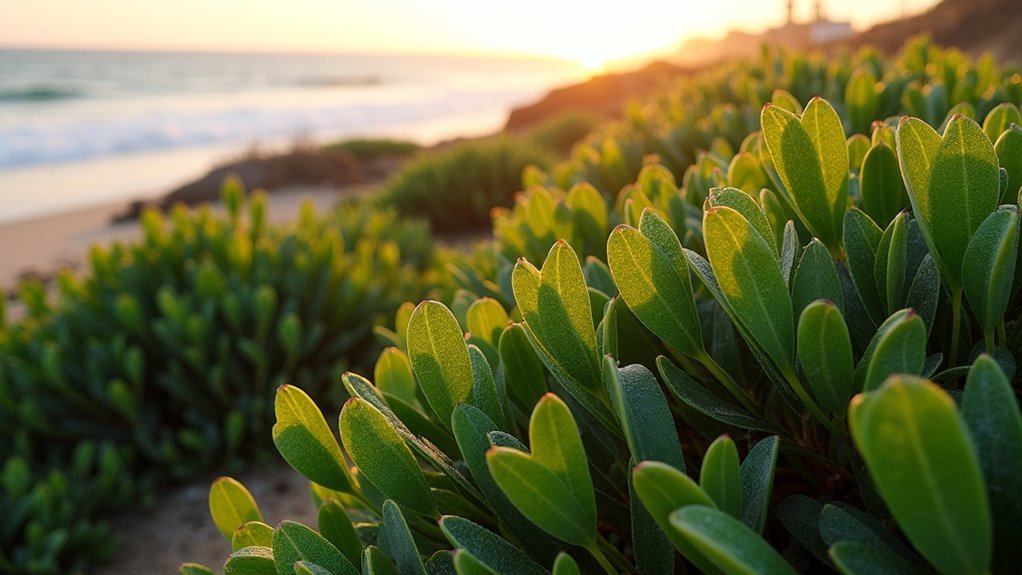
While Beach Plum offers delicious fruits along with coastal protection, property owners seeking year-round privacy will find Wax Myrtle (Morella cerifera) an outstanding solution.
This versatile evergreen shrub grows 5-10 feet tall, creating an effective natural screen that withstands harsh coastal conditions.
You’ll appreciate Wax Myrtle’s exceptional tolerance to salt spray and its ability to thrive in sandy, well-drained soil—perfect for beachfront landscapes.
Its aromatic foliage and waxy berries attract birds and wildlife, enhancing your property’s ecological value.
Plant Wax Myrtle in full sun to partial shade, and you’ll enjoy its low-maintenance nature once established.
Beyond privacy and beauty, its extensive root system helps prevent erosion, providing stability to sandy coastal soils where other plants struggle.
Rosa Rugosa: Thorny Barriers With Coastal Resilience
For property owners seeking a beautiful yet formidable barrier against coastal challenges, Rosa rugosa offers an ideal combination of toughness and charm. This resilient shrub excels in coastal environments thanks to its exceptional salt tolerance and ability to thrive where other plants struggle.
You’ll appreciate Rosa rugosa for:
- Its impressive size—growing up to 5 feet tall and 6 feet wide—creating effective natural windbreaks.
- Beautiful, fragrant pink or white summer blooms followed by edible rose hips.
- Minimal maintenance requirements once established, even in sandy or poor soils.
- Remarkable adaptability across USDA zones 2-9, making it suitable for diverse coastal regions.
This versatile shrub attracts pollinators while providing food for wildlife, making it both functional and aesthetically pleasing for your coastal landscape.
Salt Spray Rose: Creating Living Fences in Ocean-Front Settings
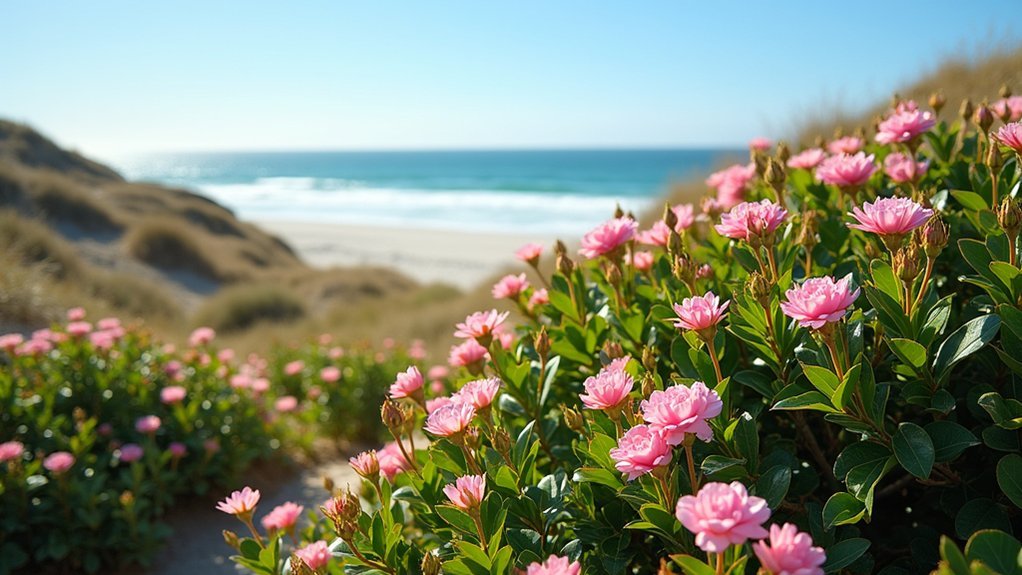
Creating stunning boundaries in challenging coastal environments becomes remarkably straightforward with Salt Spray Rose, a specialized cultivar of Rosa rugosa specifically selected for oceanfront properties.
This salt-tolerant shrub thrives where others fail, offering a dense growth habit perfect for privacy screens that stand up to harsh winds and salt spray.
You’ll enjoy fragrant blooms from late spring through fall, attracting beneficial pollinators while adding vibrant color to your coastal landscape.
Unlike typical garden plants that struggle in seaside conditions, Salt Spray Rose resists drought and poor soil, making maintenance nearly effortless.
While garden favorites wilt at shorelines, Salt Spray Rose thrives effortlessly in harsh coastal conditions other plants can’t handle.
As a bonus, you can harvest the large rose hips for teas, jams, or other culinary creations—combining beauty with practicality in one resilient coastal planting.
Inkberry Holly: Evergreen Boundaries for Brackish Soils
You’ll find Inkberry Holly thriving naturally in coastal wetlands, where it’s evolved to handle the challenging combination of salt exposure and waterlogged soils.
Its dense, year-round foliage creates effective visual barriers between properties while maintaining a tidy appearance with minimal maintenance.
These native evergreens offer substantial screening at heights of 5-10 feet, making them perfect for establishing permanent boundaries without blocking ocean views completely.
Native Wetland Adaptations
While many coastal plants struggle with fluctuating water conditions, Inkberry Holly (Ilex glabra) has evolved remarkable adaptations that allow it to thrive where saltwater meets freshwater.
This native shrub’s versatility makes it an excellent choice for your coastal property’s challenging soil conditions.
Inkberry Holly’s wetland adaptations include:
- Root systems designed to tolerate periodic flooding and salt intrusion
- Specialized leaf structures that minimize water loss in salty environments
- Ability to filter excess salt from its tissues while retaining essential nutrients
- Drought resilience during dry periods despite its preference for moist conditions
You’ll appreciate how this 3-5 foot evergreen maintains its dense foliage year-round, providing structure to your landscape while creating wildlife habitat with its small black berries.
Its salt tolerance and wetland adaptability make it exceptionally valuable for coastal gardens.
Year-Round Screening Structure
When privacy concerns meet challenging coastal conditions, Inkberry Holly offers an excellent solution for establishing lasting boundaries. This salt-tolerant evergreen thrives in brackish soils while providing year-round screening that reaches 5-10 feet tall and spreads 4-6 feet wide.
You’ll appreciate Inkberry Holly’s dense growth habit that creates effective windbreaks and privacy barriers on your coastal property. Its resilience to salt spray and adaptability to sandy soils means you won’t struggle with constant replacements or intensive care.
The shrub’s inconspicuous white spring flowers develop into black berries by fall, attracting wildlife while maintaining its structural integrity.
Plant Inkberry Holly in full sun to partial shade conditions for superior growth. Its low-maintenance nature and coastal hardiness make it a practical choice for creating enduring, functional boundaries in challenging maritime environments.
Winterberry Holly: Seasonal Interest for Coastal Property Lines

Few shrubs offer the dramatic seasonal transformation that Winterberry Holly provides to coastal property landscapes.
This deciduous native thrives in salt-influenced environments across USDA zones 3-9, making it perfect for your coastal garden boundaries.
You’ll appreciate Winterberry Holly for:
- Adaptability – Performs well in various coastal soil conditions, including wet areas and sandy spots
- Wildlife attraction – Draws birds to your property with nutritious berries
- Visual impact – Creates striking autumn displays when emerald foliage shifts color alongside vibrant red berries
- Versatile screening – Provides structure along property lines while adding seasonal interest
Remember to plant in full sun for maximum berry production, and consider placement carefully as all parts are toxic to people and pets.
Northern Juniper: Wind-Breaking Barriers for Beachfront Landscapes
Your coastal property will benefit immensely from Northern Juniper’s exceptional salt tolerance and wind resistance, creating natural barriers that protect more delicate landscape elements.
These hardy evergreens provide crucial habitat for coastal wildlife, with their berry-like cones attracting birds throughout the harsh winter months.
Beyond their aesthetic appeal, Northern Junipers help control beach erosion with their extensive root systems that effectively stabilize sandy soils along your shoreline.
Hardy Salt Protection
Although many plants struggle against relentless coastal winds, Northern Juniper stands as nature’s shield for beachfront properties. These evergreen warriors thrive in the challenging coastal environment where salt exposure would destroy most landscaping.
When you’re establishing your coastal garden, Northern Juniper offers four key benefits:
- Grows up to 65 feet tall, creating substantial windbreaks that protect your more delicate plants.
- Adapts easily to poor, sandy soils common in beachfront areas.
- Demonstrates remarkable drought tolerance, requiring minimal irrigation once established.
- Creates wildlife habitat while performing its protective duty.
You’ll appreciate how these hardy shrubs not only withstand harsh coastal conditions but actually flourish in them.
Their dense foliage effectively filters salt spray while requiring minimal maintenance—perfect for your seaside sanctuary.
Northern Wildlife Habitat
Beyond their impressive windbreak capabilities, Northern Junipers transform coastal properties into thriving wildlife sanctuaries. These resilient shrubs, with their drought resistance and ability to grow up to 65 feet tall, create essential habitat in challenging coastal environments where many plants can’t survive.
| Wildlife Benefits | Ecological Functions | Plant Characteristics |
|---|---|---|
| Bird nesting sites | Soil stabilization | Salt spray tolerance |
| Small mammal shelter | Erosion prevention | Sandy soil adaptation |
| Food sources (berries) | Windbreak protection | Drought resistance |
| Insect habitation | Microclimate creation | Evergreen foliage |
| Biodiversity enhancement | Dune reinforcement | Height up to 65 feet |
You’ll notice increased wildlife activity as your junipers mature. Their dense branches provide protected nesting areas while their root systems work below the surface, securing precious sandy soil against coastal erosion forces.
Coastal Erosion Control
When coastal properties face the relentless forces of wind and water, Northern Junipers stand as natural guardians against erosion.
These salt-tolerant evergreens create impressive windbreaks that shield your landscape from salt-laden air while simultaneously fighting coastal erosion.
You’ll appreciate how Northern Junipers protect your property in four key ways:
- Their extensive root systems stabilize sandy soils, preventing them from washing away.
- Dense foliage traps blowing sand, helping build protective dunes along your shoreline.
- Growing up to 65 feet tall, they create substantial barriers against strong coastal winds.
- Their tolerance for salty conditions means they’ll thrive where other plants fail.
Elderberry: Wildlife-Friendly Border Plants for Coastal Properties
Despite facing harsh coastal conditions, Elderberry (Sambucus canadensis) stands as an exceptional choice for property owners seeking wildlife-friendly border plants. This salt-tolerant shrub can reach impressive dimensions of 12 feet tall and 10 feet wide, creating a dense, attractive hedge for your beachfront garden.
You’ll appreciate elderberry’s adaptability to coastal challenges. It thrives in well-drained soils while tolerating occasional salt spray that would damage less resilient plants.
In spring, clusters of delicate white flowers emerge, eventually transforming into dark purple berries that attract birds and beneficial insects.
Suitable for USDA Hardiness Zones 3-8, elderberry offers versatility across various coastal climates throughout the United States, making it an ideal candidate for establishing living borders that benefit both your landscape and local wildlife.
Creating Multi-Layered Salt-Tolerant Hedgerows
While elderberry provides an excellent wildlife-friendly border option, you can enhance your coastal property’s resilience by establishing multi-layered salt-tolerant hedgerows. These protective barriers thrive in full sun and shield your landscape from harsh coastal conditions.
Create effective hedgerows by:
- Combining tall specimens like Southern Waxmyrtle (5-10 feet) with mid-sized options like Dwarf Palmetto (6-10 feet) that flourish in full sun to partial shade.
- Adding Pyracantha for seasonal interest—white spring flowers and colorful fall berries—with heights ranging from 6-18 feet.
- Including Ligustrum species (6-8 feet) for their lush green backdrop and excellent salt-tolerant qualities.
- Using a staggered planting pattern with both evergreen and deciduous shrubs to maximize light exposure while creating year-round wind protection.
This strategic approach guarantees your coastal hedgerow provides continuous beauty and functionality.
Maintenance Strategies for Coastal Shrub Boundaries
Three essential maintenance practices will keep your salt-loving coastal shrubs thriving year-round.
First, monitor soil moisture regularly, especially during dry periods, to guarantee shrubs like Southern Waxmyrtle receive adequate water without becoming waterlogged.
Apply mulch around the base of your shrubs to retain moisture, regulate soil temperature, and create a protective barrier against salt spray.
This simple maintenance strategy greatly reduces stress on your coastal plants.
Prune during dormant seasons to maintain desired shapes and remove salt-damaged foliage.
Position your shrubs strategically as windbreaks to protect more sensitive plants in your landscape.
Finally, apply salt-tolerant fertilizers specifically formulated for coastal plants.
These specialized nutrients support vigorous growth and flowering while preventing harmful salt buildup in the soil.
Frequently Asked Questions
What Shrubs Grow Well in Salty Soil?
You’ll find Southern Waxmyrtle, Live Oak, Cabbage Palm, Dwarf Palmetto, and Southern Red Cedar thrive in salty soil. They’re hardy choices that can withstand coastal conditions while providing beauty and functionality to your landscape.
What Kind of Vegetation Grows Best in Salty Waters of the Coast?
For salty coastal waters, you’ll find mangroves, spartina marsh grass, and seagrasses thriving best. Salt marsh cordgrass, pickleweed, and sea oats also adapt well to these challenging aquatic environments.
Which Plant Is the Most Tolerant to Salty Conditions?
Among the plants mentioned, Saltbush (Atriplex spp.) is your best option for extreme salt tolerance. It’s specifically adapted to thrive in highly saline environments where other plants simply can’t survive.
What Evergreens Are Salt Tolerant?
You’ll find that Live Oak, Southern Red Cedar, Dwarf Palmetto, Southern Waxmyrtle, Waxleaf Ligustrum, and Indian Hawthorn are all salt-tolerant evergreens perfect for coastal planting. They’ll withstand salt spray while maintaining year-round foliage.
In Summary
You’ll find numerous salt-tolerant shrubs that can transform your coastal property into a thriving landscape. Whether you’re seeking privacy, wildlife attraction, or edible varieties, nature offers resilient options that withstand harsh maritime conditions. By selecting appropriate species and implementing proper maintenance, you’ll create beautiful, functional boundaries that enhance your seaside home while working harmoniously with your challenging coastal environment.



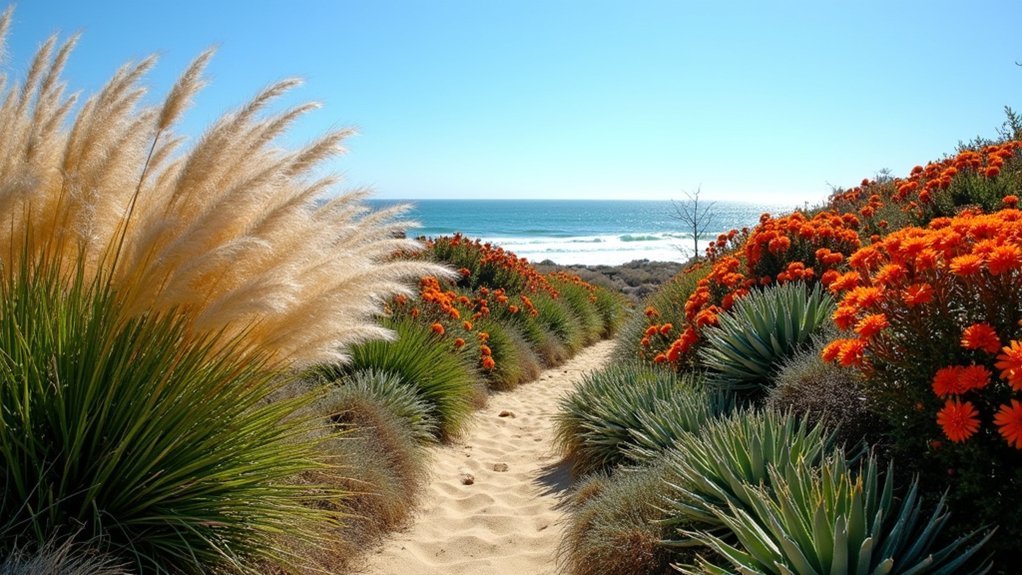
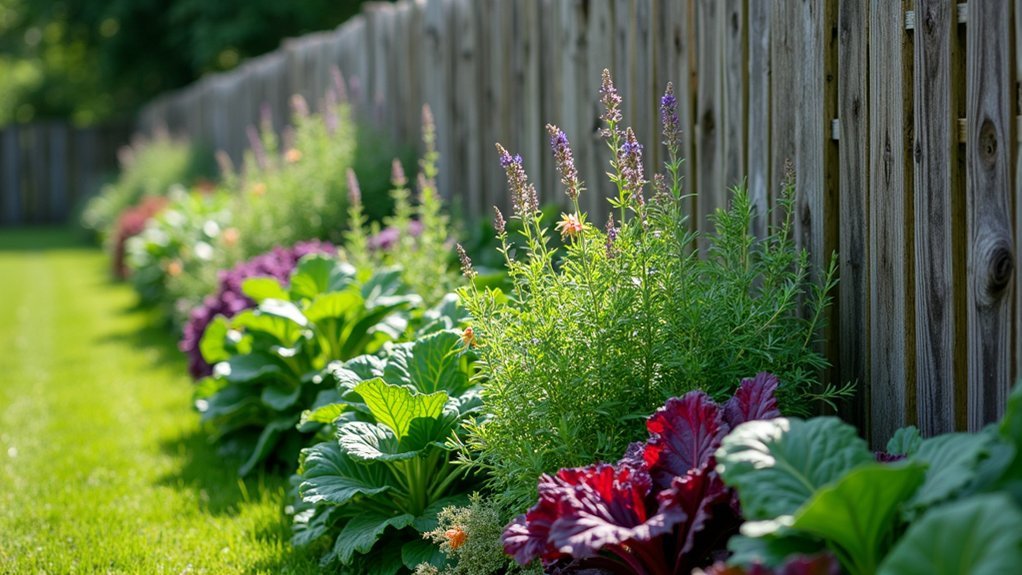
Leave a Reply